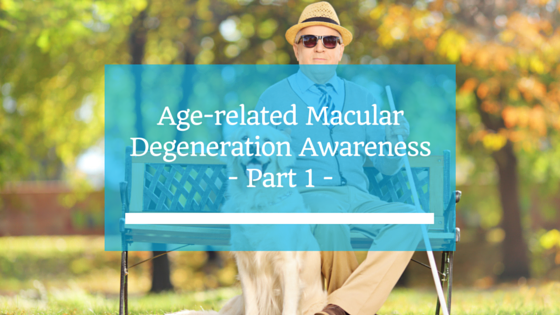
Age-related macular degeneration (AMD) is the leading cause of vision loss in people over the age of 60 (WebMD, 2016). This disease affects approximately 11 million people in the United States and by 2020, AMD is expected to affect more than 196 million people worldwide (BrightFocus Foundation, 2015).
It is a degenerative condition that affects a part of the eye called the macular and causes gradual vision loss in the centre of the vision field. The disease occurs so slowly that many people don’t realise they have the condition for years. While AMD does not cause complete blindness, the loss of vision in the middle of the vision field is significant and makes life very difficult for people with the condition.
This article will define macular degeneration, explain its symptoms and explain why Age-related macular degeneration awareness is so important.
What is Age-Related Macular Degeneration?
The macular is a yellow oval area surrounding the fovea in the centre of the eye. The fovea is a component of the eye that is responsible for providing central visual acuity. When the macular begins to generate, it can affect the ability of the fovea and cornea to function correctly.
Age-related macular degeneration is classified as early, intermediate, or late stage. Late stage AMD is further divided into “dry” and “wet” forms with the dry form making up 90% of cases.
With the dry form of macular degeneration, the light sensitive cells of the macula gradually breakdown and fail to function correctly. It is also characterised by the presence of yellow deposits, called drusen, in the macula. The yellow deposits will grow over time and begin to dim or distort the patient’s vision.
The wet form of the disease is more drastic and although it only presents 10% of late-stage AMD cases, it is responsible for 90% of cases that result in legal blindness (BrightFocus Foundation, 2015). The wet form involves the growth of abnormal blood vessels from the choroid underneath the macula. This condition is called choroidal neovascularization and can result in distorted vision as blood vessels break, pushing blood into the retina. The broken blood vessels will eventually cause scarring, which leads to permanent vision loss.
Typically, the dry form of the disease progresses into the wet form. However, in some cases patients only have the dry form of the disease and do not progress to the wet form.
Signs and Symptoms of Age-Related Macular Degeneration
The symptoms of AMD include:
- Blurry spots the centre of your vision
- Difficulty to see in low-light areas
- Written words are blurry
- You have difficulty recognising faces, particularly in low-light situations
- Your vision is hazy and not clear
- Colours seem less vivid
It can be difficult to recognise these symptoms in the early stages of the diseases, but they gradually become more noticeable over time.
Causes of Age-Related Macular Degeneration
Researchers still don’t know the causes of AMD, but they have identified some risk factors including:
- Age
- Family history of Macular Degeneration
- Poor diet, obesity or high cholesterol
- Low macular pigment density
- Smoking
- Farsightedness
- Sun exposure
The Importance of Age-Related Macular Degeneration Awareness
Research from Australia found that public age-related macular degeneration awareness campaign that ran between 2007 and 2011 increased awareness of the disease by 58% to 92% in those aged 50 years or older (Heraghty & Cummins, 2012). The rate of people having their macula checked increased from 33% to 70% in that time, highlighting the importance of public awareness.
Awareness can lead to more people obtaining an early diagnosis and receiving treatment for their condition. The earlier a person can receive a treatment for macular degeneration, the less likely they will suffer catastrophic central vision loss. While it is not possible to cure AMD, it is possible to slow the progression of the disease.
Early diagnosis allows patients to modify their diet and behaviour, slowing the progression of AMD. Increased public awareness also encourages people who have a family history of AMD to have their vision checked.
New anti-VEGF (vascular endothelial growth factor) treatments can also slow the progression of the “wet” form of AGD and can even improve the vision of AMD sufferers. It is important to make people aware of the condition so they can seek this form of treatment as early as possible — before the blood vessels cause scarring and permanent vision loss. Many countries now have an age-related macular degeneration awareness month or week to help the public understand this potentially debilitating condition.
Part II of this article will take a look at the ongoing research projects which seek to find new treatments for age-related macular degeneration.
Sources
BrightFocus Foundation,. (2015). Age-Related Macular Degeneration: Facts & Figures. Retrieved 10 February 2016, from http://www.brightfocus.org/macular/article/age-related-macular-facts-figures
WebMD,. (2016). Age-Related Macular Degeneration Overview. Retrieved 10 February 2016, from http://www.webmd.com/eye-health/macular-degeneration/age-related-macular-degeneration-overview
Heraghty, J., & Cummins, R. (2012). A Layered Approach to Raising Public Awareness of Macular Degeneration in Australia. Am J Public Health, 102(9), 1655-1659. http://dx.doi.org/10.2105/ajph.2012.300657
{{cta(‘3fe0aac7-7562-46dc-b8b9-c706d9cfd6b1’)}}


